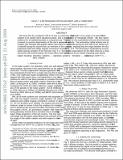| dc.contributor.author | Winn, Joshua Nathan | |
| dc.contributor.author | Johnson, John Asher | |
| dc.contributor.author | Albrecht, Simon H. | |
| dc.contributor.author | Howard, Andrew W. | |
| dc.contributor.author | Marcy, Geoffrey W. | |
| dc.contributor.author | Crossfield, Ian J. | |
| dc.contributor.author | Holman, Matthew J. | |
| dc.date.accessioned | 2010-03-03T15:55:38Z | |
| dc.date.available | 2010-03-03T15:55:38Z | |
| dc.date.issued | 2009-10 | |
| dc.date.submitted | 2009-08 | |
| dc.identifier.issn | 2041-8213 | |
| dc.identifier.issn | 2041-8205 | |
| dc.identifier.uri | http://hdl.handle.net/1721.1/52004 | |
| dc.description.abstract | We show that the exoplanet HAT-P-7b has an extremely tilted orbit, with a true angle of at least 86° with respect to its parent star's equatorial plane, and a strong possibility of retrograde motion. We also report evidence for an additional planet or companion star. The evidence for the unparalleled orbit and the third body is based on precise observations of the star's apparent radial velocity (RV). The anomalous RV due to rotation (the Rossiter-McLaughlin effect) was found to be a blueshift during the first half of the transit and a redshift during the second half, an inversion of the usual pattern, implying that the angle between the sky-projected orbital and stellar angular momentum vectors is 182fdg5 ± 9fdg4. The third body is implicated by excess RV variation of the host star over 2 yr. Some possible explanations for the tilted orbit of HAT-P-7b are a close encounter with another planet, the Kozai effect, and resonant capture by an inward-migrating outer planet. | en |
| dc.language.iso | en_US | |
| dc.publisher | American Astronomical Society | en |
| dc.relation.isversionof | http://dx.doi.org/10.1088/0004-637x/703/2/l99 | en |
| dc.rights | Attribution-Noncommercial-Share Alike 3.0 Unported | en |
| dc.rights.uri | http://creativecommons.org/licenses/by-nc-sa/3.0/ | en |
| dc.source | Josh Winn | en |
| dc.title | HAT-P-7: A RETROGRADE OR POLAR ORBIT, AND A THIRD BODY | en |
| dc.type | Article | en |
| dc.identifier.citation | HAT-P-7: A Retrograde or Polar Orbit, and a Third Body
Joshua N. Winn, John Asher Johnson, Simon Albrecht, Andrew W. Howard, Geoffrey W. Marcy, Ian J. Crossfield, and Matthew J. Holman 2009 ApJ 703 L99-L103 doi: 10.1088/0004-637X/703/2/L99 | en |
| dc.contributor.department | Massachusetts Institute of Technology. Department of Physics | en_US |
| dc.contributor.department | MIT Kavli Institute for Astrophysics and Space Research | en_US |
| dc.contributor.approver | Winn, Joshua Nathan | |
| dc.contributor.mitauthor | Winn, Joshua Nathan | |
| dc.contributor.mitauthor | Albrecht, Simon H. | |
| dc.relation.journal | Astrophysical Journal. Letters | en |
| dc.eprint.version | Author's final manuscript | |
| dc.type.uri | http://purl.org/eprint/type/SubmittedJournalArticle | en |
| eprint.status | http://purl.org/eprint/status/PeerReviewed | en |
| dspace.orderedauthors | Winn, Joshua N.; Johnson, John Asher; Albrecht, Simon; Howard, Andrew W.; Marcy, Geoffrey W.; Crossfield, Ian J.; Holman, Matthew J. | en |
| dc.identifier.orcid | https://orcid.org/0000-0002-4265-047X | |
| mit.license | OPEN_ACCESS_POLICY | en |
| mit.metadata.status | Complete | |
